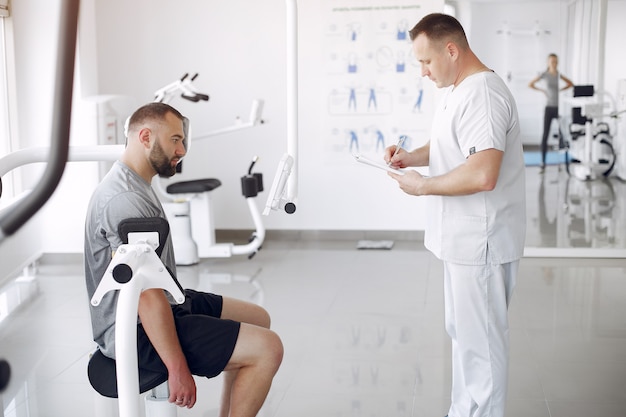Sports injuries are a common concern for athletes of all levels. Effective rehabilitation is crucial for recovery and returning to peak performance, whether it’s a sprain, strain, or more severe injury. Sports physiotherapists use techniques to address common sports injuries, helping athletes regain strength, flexibility, and function. Here are some key rehabilitation techniques used for common sports injuries.

1. Manual Therapy
What It Is: Manual therapy involves hands-on techniques to manipulate and mobilize muscles, joints, and soft tissues. It aims to reduce pain, improve range of motion, and restore normal function.
Common Techniques:
- Joint Mobilization: Gentle movements are applied to joints to improve their range of motion and reduce stiffness.
- Soft Tissue Massage: Techniques to relieve muscle tension, improve blood flow, and decrease pain in the affected muscles.
They are used For Sprains, strains, and joint injuries.
2. Strengthening Exercises
What It Is: Strengthening exercises are designed to rebuild muscle strength and endurance after an injury. They focus on targeted muscle groups to enhance stability and support.
Common Exercises:
- Resistance Training: Using weights or resistance bands to increase muscle strength.
- Functional Exercises: Movements that mimic the demands of the sport, such as squats for lower body strength or shoulder presses for upper body strength.
They are used For Muscle strains, ligament injuries, and post-surgery recovery.
3. Stretching and Flexibility Exercises
What It Is: Stretching exercises improve flexibility and range of motion, which can help prevent further injuries and enhance overall function. If you’re in Pune and seeking expert care for recovery, The Physio9 Clinic offers personalized rehabilitation treatments designed to enhance healing and restore your mobility. Trust the best sports physiotherapist in Pune to guide your rehabilitation journey and improve your quality of life.
Common Techniques:
- Static Stretching: Holding a stretch for a period to lengthen the muscles.
- Dynamic Stretching: Moving through a range of motion in a controlled manner to warm up muscles before activity.
They are used For Tight muscles, joint stiffness, and recovery from overuse injuries.
4. Balance and Proprioception Training
What It Is: Balance and proprioception training focuses on improving athletes’ ability to sense their body’s position and movements. This helps enhance coordination and prevent falls or re-injury.
Common Exercises:
- Balance Boards: Standing on unstable surfaces to improve balance and core stability.
- Single-Leg Stands: Holding a balanced position on one leg to strengthen stabilizing muscles.
They are used For Ankle sprains, knee injuries, and post-surgery rehabilitation.
5. Modalities and Electrical Stimulation
What It Is: Various modalities and electrical stimulation techniques manage pain, reduce inflammation, and promote healing.
Common Modalities:
- Cryotherapy (Ice Therapy): Applying ice to reduce swelling and numb pain.
- Heat Therapy: Using heat to relax muscles and improve blood flow.
- Electrical Stimulation: Using electrical currents to stimulate muscles and nerves can help with pain relief and muscle re-education.
They are used For Acute injuries, muscle soreness, and chronic pain.
6. Functional Rehabilitation
What It Is: Functional rehabilitation focuses on restoring athletes’ ability to perform sport-specific movements and activities. It includes exercises and drills that mimic the actions required in their sport.
Common Techniques:
- Sport-Specific Drills: Practicing movements specific to the athlete’s sport to ensure a smooth transition back to play.
- Agility Training: Exercises that improve speed, coordination, and quick directional changes.
They are used To Recover from sports-specific injuries, such as ACL tears, and improve performance.
7. Education and Self-Management
What It Is: Education plays a crucial role in rehabilitation by teaching athletes about their injuries, the healing process, and strategies for preventing re-injury.
Common Topics:
- Injury Prevention: Techniques and exercises to avoid future injuries.
- Activity Modification: Guidance on how to adapt activities to prevent strain on the injured area.
- Posture and Technique: Advice on proper posture and technique during sports activities.
They are used for all injuries, particularly long-term recovery and prevention.
Common Sports Injuries and Their Rehabilitation Techniques
1. Ankle Sprains
Rehabilitation Techniques:
- Rest and Ice: Initial treatment to reduce swelling and pain.
- Range of Motion Exercises: Gentle movements to restore joint flexibility.
- Strengthening Exercises: Focus on ankle stability and strength.
- Balance Training: To prevent re-injury and improve proprioception.
2. ACL Tears
Rehabilitation Techniques:
- Pre-Surgery Therapy: Strengthening exercises to prepare the leg for surgery.
- Post-Surgery Rehabilitation: Includes strengthening, range of motion, and functional exercises.
- Sport-Specific Drills: Gradual return to sport-specific movements and agility training.
3. Hamstring Strains
Rehabilitation Techniques:
- Rest and Ice: To manage pain and swelling.
- Gentle Stretching: To improve flexibility without overstretching.
- Strengthening Exercises: Focused on the hamstrings and surrounding muscles.
- Functional Exercises: To return to running and sport-specific activities.
4. Shoulder Injuries
Rehabilitation Techniques:
- Manual Therapy: To improve joint mobility and reduce pain.
- Strengthening Exercises: Focus on rotator cuff and shoulder stabilizers.
- Stretching and Mobility: To restore range of motion and flexibility.
Conclusion
Sports physiotherapy offers a comprehensive approach to managing and rehabilitating common sports injuries. By employing techniques such as manual therapy, strengthening exercises, stretching, balance training, and functional rehabilitation, sports physiotherapists help athletes recover efficiently and return to their sport with enhanced performance and reduced risk of future injuries. If you’re dealing with a sports injury or aiming to prevent one, consider working with a sports physiotherapist to develop a personalized rehabilitation plan tailored to your needs and goals. You can recover and maintain peak athletic performance with the right support.